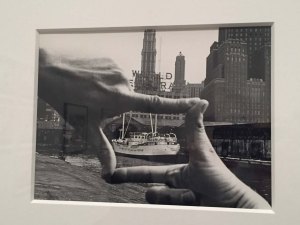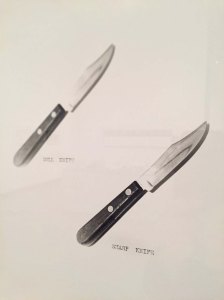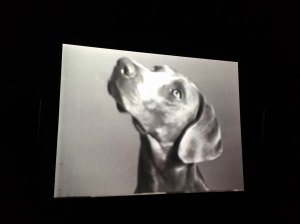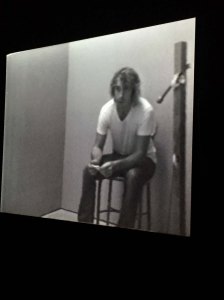Sometimes losing a job is a good thing. Or at least that seems to be what happened to William Wegman, when his contract to teach in the art department didn’t get renewed by the University of Wisconsin – Madison back in 1970.
Like so many others Midwesterners, he packed up and moved to sunny Los Angeles, where the contemporary art scene was just starting to take off.
It ended up being a career-making move that he didn’t see coming.

Photo of 1971 performance-art piece by California artist John Baldassari, “Hands Framing New York Harbor, from Pier 18”
The Metropolitan Museum of Art’s exhibition, “Before/On/After: William Wegman and California Conceptualism”, on view through July 15, harkens back to the three years that Wegman lived in SoCal, populated by other up-and-comers like Ed Ruscha, John Baldassari, David Salle, and Vija Celmins.
The Seventies-era Chicago, Madison, and California art scenes generally had more wit, whimsy, and lightheartedness than the super-serious East Coast art scene, which was showcasing droves of red-hot Conceptual and series artists from New York and Europe, such as Hanne Darboven, Lawence Weiner, and the Belchers.
At the time, New York gallery walls were full of framed mathematical series and formulas, endlessly rigorous permutations, semiotic variations, deconstructed analyses, and meticulously documented minimalist photo series. California was the antithesis, with artists poking gentle fun and creating works that were more pop-culture-oriented head-fakes.
By 1970, artists were experimenting with video for the first time, courtesy of Sony’s invention of the Portapak. It was grainy, but you could monitor what you were shooting as you were doing it.
When Wegman arrived in LA, he planned to continue his work, including making short, witty performance videos involving props and sets. But he had an unexpected problem: his wife’s insistence on getting a large dog in LA saddled him with babysitting Man Ray, a big, busy Weimaraner that continuously investigated the props in the studio and gave him spooky, soulful looks as he performed.
When Wegman decided to involve Man Ray in the set-ups and teach him about the serial nature of East-Coast conceptual art, the short videos became insightful and engaging. The first canine art-world star was born.
Although Wegman and Man Ray left California to move back East a few years later, the collaboration was a watershed moment in Wegman’s career. Every New York and European gallery clamored to include works with Man Ray alongside Wegman’s other photos and performance videos.

1972 Wegman photo “Dull Knife/Sharp Knife”, referring both to the object and the viewer’s own mental acuity in deciphering art
The Met’s show, near the second-floor photography galleries, is a tribute to the fun, inquisitive nature of the Southern California art scene at this turning point in Wegman’s life and was created to honor a special gift: Wegman and Christine Burgin, his wife, donated 174 of these short videos to the Met, along with some of the California photographs and drawings.
To honor this bequest, the Met has created a small black-box theater inside the gallery, where everyone can delight to 99 minutes of less-than-two-minute videos featuring Man Ray and his owner, mostly from the early years.
It’s a chance to see what everyone saw at The Kitchen and Sonnebend when Soho was still an industrial neighborhood.
The videos are all rough low-resolution snippets that seem to have several layers of meaning. In one, Man Ray propels a glass bottle around the floor of the studio in an effort to extract a biscuit that is trapped inside. In another, the camera stays tight on Man Ray’s face to record the subtle changes in expression as he silently responds to a series of Wegman’s questions, which all begin with “Man Ray, do you want to….?”
East Coast audiences for painstaking methodological investigation and serial word-art never had it so good! Man Ray was everyone’s favorite canine conceptual artist.
The rest of the show features books and photographs from the Met’s collection by Ed Ruscha, Baldessari, and other artists that Wegman knew when he was just starting out.
Take a look at all of the work in the exhibition on the Met’s website, which also includes stills from many of the videos in the show. Check out the photos on our Flickr site.
But spend some time on the second floor of the Met, enjoying the early work of a witty, shaggy, out-of-the-box artist and his clever, not-so-shaggy dog.
The Met — and Wegman’s black-box cinema — is open 7 days a week and until 9pm Friday and Saturday.





